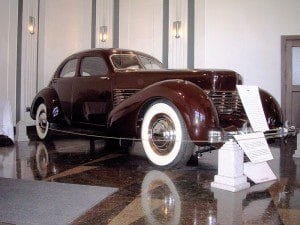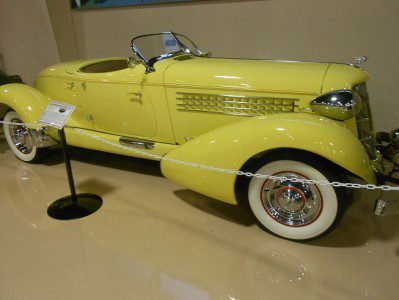Out of all of the automobile industry companies the Auburn Automobile Company has a unique history and produced some great classic cars. The Auburn Automobile Company was founded in Auburn Indiana and was at one time the Eckhart Carriage Company. The company was founded only after two Eckhart brothers experimented with car building for a few years. The automobiles produced by the Auburn company were priced on the higher end. In many ways it was marketed to much wealthier buyers as compared to Ford’s Model T and Model A. While the Model T was a car for everyone, the Auburn’s were automobiles for the fewer. The Auburn automobiles were hand produced as opposed to mass production.

The Eckhart brothers left the auto business in 1919 when they sold out to a group of Chicago investors. World War One had been tough for the company with a lot of difficulty getting materials. This could very much explain the 1919 buyout. The previous few years were tough ones for Auburn and the brothers welcomed a buyer. The Chicago buyout group was headed by none other than William K. Wrigley Jr., the chewing gum titan. The new group did a lot with designs and built the “Beauty Six” with a new streamlined body style, windshield vents and disc wheels. All of this was well and good but there was a severe post-war recession and by the year 1924 the company was in trouble again. At this point they looked for outside help to ratchet up sales.
The next person to enter Auburn’s picture was Errett Lobban Cord. Cord was a salesman’s salesman and had sold for the Moon Motor Car Company for their Chicago market.

While his background was in sales, Cord took on the position as general manager for Auburn. This was his first foray into the production end of the business. By 1926 he was not only president of the company but was it’s principal shareholder. Cord also partnered with the racing car company Dusenberg. Things picked up for Auburn after Cord came in and they were selling V-8’s at very reasonable prices. By the year 1929, Auburn was selling 20,000 + cars annually. After 1930, Auburn dropped their six cylinder engines and were putting out both eight and twelve cylinder models. The very first Auburn eight originally debuted in 1925 and was named “the eight-in-line”. In 1930, the Great Depression was picking up steam and Auburn decided that there just wasn’t enough profit in the six cylinder cars. The twelve cylinder engines however had a relatively short life span and ended production in 1934.
Unfortunately for Auburn, the depression ate hard into sales and by 1937 the automaker halted production. There were also stories about stock manipulation by Cord and trouble with the SEC that hastened the automaker’s downfall.

Historically, Auburn is known for it’s imaginative designing and advanced engineering. Teaming up with Dusenberg in 1926 allowed Auburn to sell higher cost luxury cars with racing flare. One very popular car put out by Auburn during it’s last few years of existence, and after Harold Ames became president of the company, was the “Speedster 851” model. Many of the Auburn Speedsters were powered with straight eight engines and “superchargers”. To give you an idea of the car’s specs, the 1935 Speedster 851 model came with an eight cylinder Lycoming engine, a three speed manual with synchromesh, weighed 3,352 pounds, had 150 HP and could go from 0 to 60 MPH in about 15 seconds.

The car also was available with the option of a Schweitzer-Cummins Supercharger and had rear wheel drive. The “supercharged” models even had the word “supercharged” shown on both sides of the engine cover. If you owned one of the supercharged models in 1935, you wanted people to know. The Auburn Speedster supercharged models were easily recognized by their four external exhaust headers. This was truly a luxury racer in many ways and today is among truly classic cars.
The stock car version of the 851 Speedster, also called the “Auburn Boattail” averaged some 100 MPH over a twelve hour run in 1935. This event alone helped sell the new improved Auburn Speedster. Officially the car was advertised with a top speed of 100 MPH. The company sold about 5,000 of the 851’s in 1935 and then saw sales drop significantly. They did introduce a Speedster 852 in 1936 but the car was essentially the same as the 851 model and surprisingly sales dropped more than fifty-percent. As you can imagine, the 1935 Speedster 851 is quite a collector’s prize today. Another model put out by Auburn Cord Dusenberg in 1936 was the Cord 810 shown above. The car was unique in as much as it offered front wheel drive with independent front suspension. It also sported a semi-automatic four-speed transmission. The car was powered with 190 HP. The Cord was a separate design owned by by E.L. Cord but was manufactured by Auburn.
The Auburn Speedster model is what most people remember today about the Auburn cars. The company was very innovative and had excellent designers but the downfall appeared to have more to do with financial manipulation than anything to do with the fine products they were putting out.
Today, auto enthusiasts can visit the art deco former headquarters of the Auburn Automobile Company in Auburn Indiana. The building is now the Auburn Cord Dusenberg Automobile Museum. One of the things that makes this museum historically significant is that it was here where Auburn Cord Dusenberg manufactured automobiles by hand. Obviously a rarity today. The museum is located at 1600 Wayne Street in Auburn Indiana and is on the National Register of Historic Places.
You may also be interested in our articles on the Lotus Elise automobile and the Morgan Aero 8.
While in Auburn Indiana you’ll also want to check out the Kruse International Classic and Collector Car Auction. Some 5,000 cars are put on auction each day beginning in September.
(Photos and images from the public domain)
